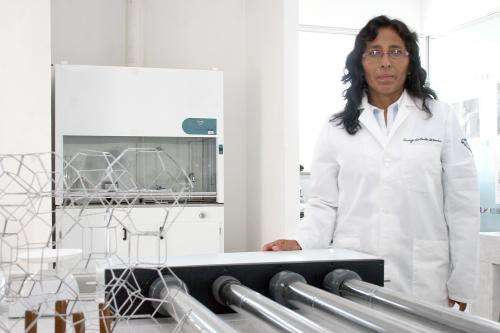Solar cooling system keeps water at nine degrees Celsius for up to three months

Maintaining food in places where high temperatures prevail, using little energy at a low cost, is now possible with Mexican technology, thanks to the creation of a solar cooling system designed by Susana Elvia Toledo Flores.
The prototype developed in the Research Department in Zeolites, at the Institute of Science of the Meritorious University of Puebla (BUAP), in center Mexico, works 24 hours per day and maintains the temperature for up to three months.
The researcher developed the prototype in the Black mountain range, where she developed the system maintain water at nine degrees Celsius. "With that temperature, we can cool food, though the goal is to get as low as five degrees. Then fish can be preserved without denaturing its proteins".
The BUAP design is inexpensive, easy to manufacture and environmentally beneficial. "Normal cooling systems use chlorofluorocarbon chemicals that destroy the ozone layer and contribute to greenhouse gases. Ours is friendly to the environment," explains Toledo Flores.
It works with solar radiation and the cooling is achieved by means of a thermodynamic adsorption-desorption cycle lasting 24 hours. Methanol is used as a refrigerant and as zeolite (mineral) as an adsorbent.
Toledo Flores says the system has two stages. During the day, "warming, desorption and the period of condensation happens. Solar energy heats the zeolite and increases the methanol vapor pressure, and the refrigerant is condensed and stored in a tank flowing to the evaporator. "
Overnight, the cooling process is achieved, and the adsorption and evaporation period occurs. "The adsorbent bed temperature decreases after sunset. Therefore, the refrigerant pressure is reduced and evaporates while the absorbent is cooled. During this period, the coolant begins to evaporate and is again adsorbed by zeolite, generating cooling temperatures of five degrees Celsius. The adsorption process continues all night until morning. "
The equipment is composed of a solar collector, adsorbent bed, condenser and evaporator. To build it, the researcher calculates the amount of water to be cooled, and therefore how much zeolite to use. She also considers the room temperature, in this case, 20 degrees Celsius.
Furthermore, the system "is not only designed to cool foods. It may also serve as an air conditioner, for example, in communities like Tecali de Herrera, Puebla, where there are areas without electricity. The system could adapt well to preserve their foods and medicine, bringing them better quality of life," says Toledo Flores.
The project was presented at the International Congress of Solar Energy at Germany where it was well received as economical, safe and efficient. Germans are interested in investing in Mexican solar projects.
Provided by Investigación y Desarrollo




















